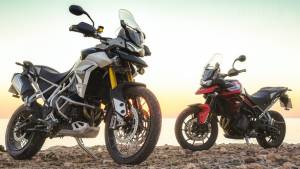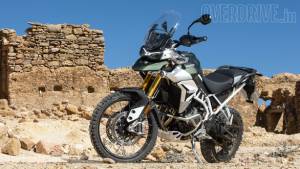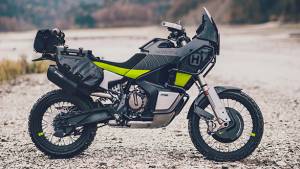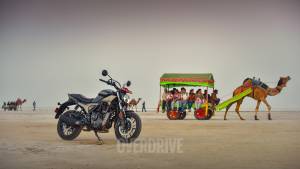Triumph Tiger 900 GT Pro and Rally Pro first ride review
They say the desert tells a different story every time one ventures on it. With learnings from my recent trip to Morocco, I would agree. The first dune of sand that I hit with the new Tiger 900 was a monster that swallowed half the rear wheel on the bike and wouldn't let go of it. Later, when we fished the trail and came back to the same dune again, it acted friendly and slid the bike nicely for a rooster tail of sand. Too bad the photographers weren't in position (true for most of the ride) to capture the action from the story. But yes, every bit of the desert presents a different picture every time. But the Tiger doesn't have such mood swings. It's consistent and the new one feels like a sequel to the previous one - not rewriting anything, and yet making plot all the more interesting.
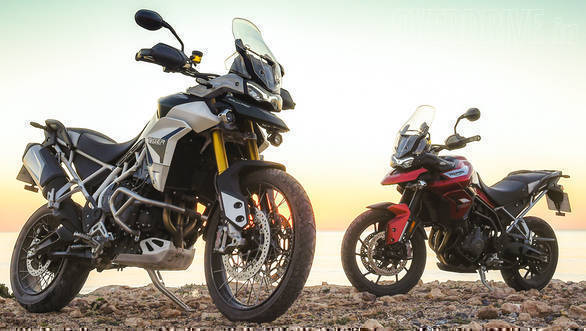 The Triumph is the replacement to the highly successful Tiger 800 line up and as before there are two model lines - a road-going GT (right) and the cross-country friendly Rally (left)
The Triumph is the replacement to the highly successful Tiger 800 line up and as before there are two model lines - a road-going GT (right) and the cross-country friendly Rally (left)
Like most other bike makers, Triumph too has had to bump up engine capacity on the new Tiger to comply with the Euro V standards without compromising of the performance. The new engine displaces 888cc and I believe that a "Tiger Triple-Eight" would have been such a cooler name. But they have stuck to the convention with the Tiger 900 christening, which also pays homage to its namesake from '93, which was the first Triumph Tiger to embark on the adventure motorcycle genre. As before, it is only the engine that is common to the new Tiger 900 line-up, while the chassis and suspension are different for the new GT and Rally lines, which replace the road going XR and off-road biased XC lines of the outgoing Tiger 800. Of the many sub-variants that these model lines posses, the GT Pro, Rally and Rally Pro models will head to India this April.
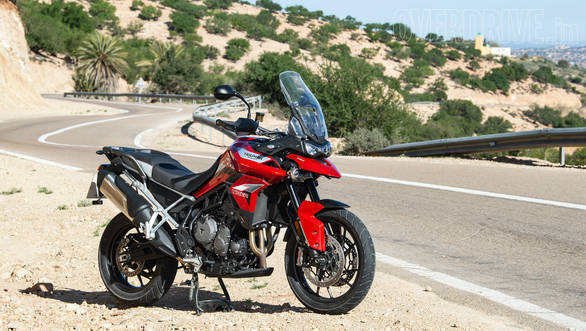 The Tiger Pro is the equivalent of the Tiger 800 XRx in the outgoing line-up
The Tiger Pro is the equivalent of the Tiger 800 XRx in the outgoing line-up
If you are going to spend most of the saddle time on the tarmac, sport touring and even riding to work, the GT Pro is the Tiger that is ideally suited for you. To that effect, it uses cast wheels - 19 front, 17 rear - has an electronically adjustable rear suspension, cruise control, riding modes that alter the response of the engine, the electronic nannies and the rear suspension, and a big 7-inch dashboard that pairs to your phone for satellite navigation and for even controlling your GoPro!
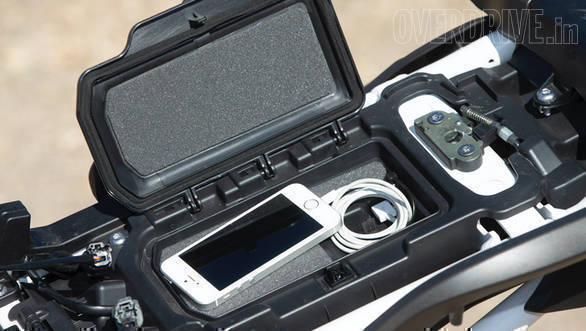 The Tiger features a shallow under-seat compartment (equipped with a USB 3.0 charger) to stow away your phone
The Tiger features a shallow under-seat compartment (equipped with a USB 3.0 charger) to stow away your phone
The GT Pro is the top-spec model in the Tiger GT range and therefore all these headlining features are what you will get in India. While both the variants look very similar, GT Pro has a lower seat height which most Indians will appreciate and choose over the taller Rally Pro. We have also nudged Triumph to consider the low-ride-height variant for India, which makes this big adv almost as manageable as a Street Twin!
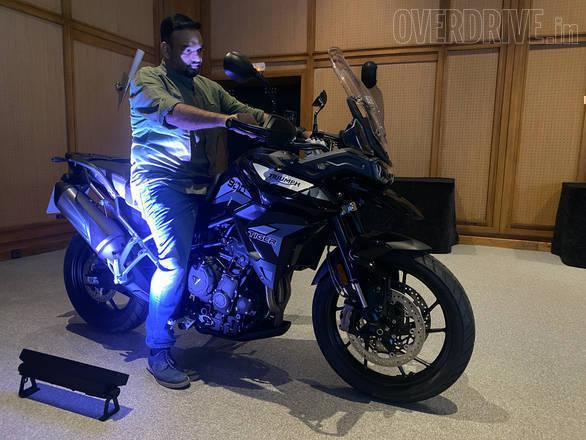 The low-ride-height Tiger GT seen here has an adjustable seat height of 760mm-780mm. In comparison, the GT allows 810-830mm, while the Rally will seat you between 850-870mm from the ground
The low-ride-height Tiger GT seen here has an adjustable seat height of 760mm-780mm. In comparison, the GT allows 810-830mm, while the Rally will seat you between 850-870mm from the ground
Both the 900s are a lot leaner to look at than their outgoing counterparts and all the models are at least 5kg lighter than before. The leaner stance is largely attributed to the new a la Africa Twin headlights, which now have single function headlamps for the upper and lower beams respectively. The throw is better than the outgoing units but I would recommend larger aftermarket auxiliary lights. The beak is a standard fitment now and has a stronger mounting than before. The rear grab rails are chunkier and less intrusive for the pillion while getting on or off.
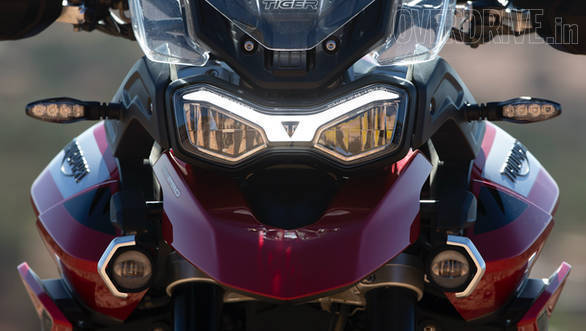 The new Tiger 900 has a unibrow LED daytime running lamp, and LED headlamps, turn-blinkers and auxiliary lights - all of which are standard on the GT and Rally Pro variants headed to India
The new Tiger 900 has a unibrow LED daytime running lamp, and LED headlamps, turn-blinkers and auxiliary lights - all of which are standard on the GT and Rally Pro variants headed to India
Most of the weight savings come from the chassis and the engine, while their revised geometries also make a difference to the way the Tiger feels now. The new chassis is narrower at the top, which allows the seat and tank to have a narrower profile - so even though the seat height figures seem high, is it easy to ground your feet flat for most riders. The chassis also has a modular arrangement now, which has also allowed for a multi-material construction - a steel mainframe which ensures rigidity, and lighter aluminium construction for sub-frame and the rear footpegs, both of which are also removable and replaceable in case of damage - something that off-road enthusiasts would appreciate.
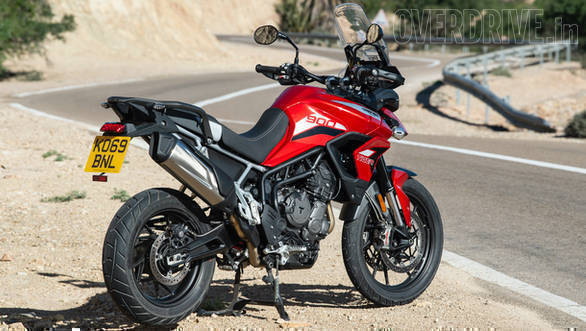 The rear subframe and footpegs are made in aluminium and are removable and replaceable
The rear subframe and footpegs are made in aluminium and are removable and replaceable
At the front end of the chassis, the radiator now has a split design, which has allowed a wider and rear-set placement of two cooling units, opening up more room at the front for changing the chassis and suspension geometry. The angled placement has allowed the exhaust vents to channel the hot air outward and away from the rider's knees. But you will still hug the frame, and therefore, in bumper to bumper traffic, you still feel quite a bit of the heat. The overall thermal management is much better than before, assures Triumph. My only concern with the placement of the radiators is that the rectifier now finds home on the spine between the two radiators, where it catches all the muck flying off the from the front wheel. If you ignore it, the muck cakes upon the heatsink and is likely to toast the rectifier - needing particular attention on long travels. The larger mudguard from the Rally Pro could solve this issue for the GT Pro.
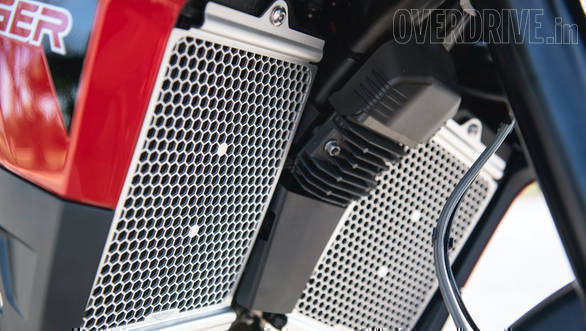 The rectifier sits in a vulnerable position on the new Tiger 900
The rectifier sits in a vulnerable position on the new Tiger 900
The starter motor is now more robust than before, so I expect better longevity and endurance in Indian conditions. Though I couldn't confirm it visually, Triumph reps tell us that the exhaust system has been redesigned as a three-piece unit where the cat-con sits independently. The tank has been redesigned too. And though it now looks slimmer than before, it has a marginally larger capacity of 20l. Interestingly, with the Euro 5 regulations, the claimed economy has gone down (5.2l/100kms versus 4.7l/100kms) so even with the larger tank, the range is going to be marginally lesser than the outgoing 800. The fuel is also stored slightly lower than before, future reducing the top-heavy nature of the bike. With that redesign, Triumph has finally addressed the position of the air filter, which is now accessible from under the seat, eliminating the need to remove the tank as in the Tiger 800.
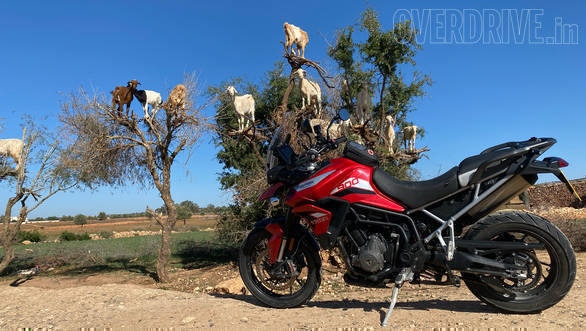 The go-anywhere capabilities of the Tiger GT Pro are limited
The go-anywhere capabilities of the Tiger GT Pro are limited
All these design changes have allowed a massive change in the rake and trail of the motorcycle. That has not only altered the wheelbase, but it has also created more room at the front, allowing Triumph to tilt the engine forward and set it slightly lower than before. With the repositioning, it requires a slightly shorter chain now, and the rubbing strip under the cabin has been redesigned for lesser noise and better longevity. The pivot point for tilting the engine is still around the mounting of the swingarm. The oil sump is now smaller too, and needs half a litre lesser oil - so those are further weight savings.
Inside the engine, the cylinder-sleeves have been redesigned to share their walls and create one single unit - so that has not only saved more weight, but it has also allowed for pistons that are 4mm larger in diameter, achieving the increased cubic capacity.
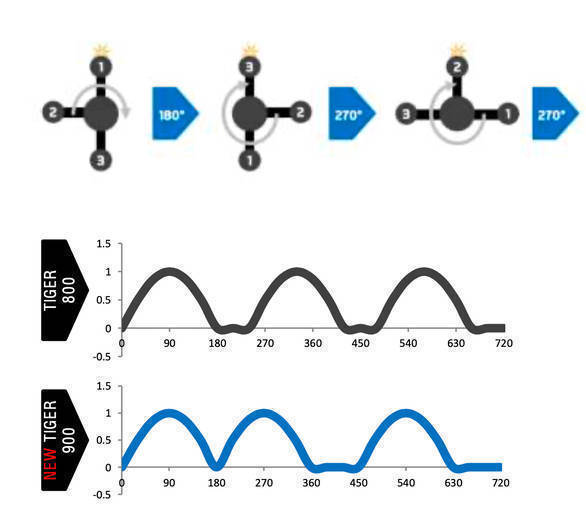 The Tiger 900 has a different firing order and crankpin arrangement, giving it a very aural and practical character than the 800
The Tiger 900 has a different firing order and crankpin arrangement, giving it a very aural and practical character than the 800
All these changes translate to the new Tiger feeling light to manoeuvre in the parking lot too and the advantages are even larger out on the road. The ergonomics are better and the bike instantly feels light on its feet. The bigger change to the engine is the T-plane crankshaft, a technology similar to Yamaha's Crossplane Crank. The crankpins are 90-degrees from each other, and the firing order has been changed from 1-2-3 on the 800, to 1-3-2 on the new 900. That creates uneven pulses and what you get is a raspy new tone for the engine compared to the smooth, peaky, whistling sound of the previous triple. We fired up the old and new bike and the difference in the two is massive (watch our video review to take a listen).
For those who love the smooth sound of the previous model, the new grunt tone may not sound as exciting - so I'm predicting polarising opinions of this one. I quite like the way the engine sounds. But the sound is just a byproduct. The new configuration of the crank aims to give you two engines in one - a torquey parallel twin rivalling performance at the low-end, and a rev-happy fast motor at the top end like the previous 800. To find out if it really does that, we rode from Marrakech to Essaouira in Morocco across varied terrain for three days!
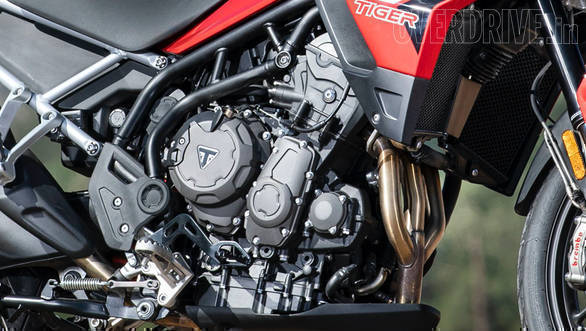 The new 888cc liquid-cooled engine puts out 95.2PS at 8,750rpm and 87Nm at 7,250rpm
The new 888cc liquid-cooled engine puts out 95.2PS at 8,750rpm and 87Nm at 7,250rpm
If the previous Tiger has intimidated you with its bulk, the new one probably won't do as much. It feels light on its feet from the get-go without losing its "big bike" feel. The increased cubic capacity of the engine has bumped up the torque output to 87Nm and it is now available earlier in the rev range (7,250rpm versus the 800's 8,050rpm), but the power output still remains the same.
The specs leave you wanting for the magical 100+PS figure, but alas, the A2 licensing norms have ruined the party. The A2 license for beginner-motorcyclists isn't something that concerns India so much, but in the countries that have it, Triumph is offering a kit at the dealer level that will restrict the power output to the wheel to achieve the A2 norms. Triumph says that even if they had increased the power by 1PS over 95, they would have achieved the target with the restrictor. Sadly, even the official Arrow slip-on end-can will not bump power - instead, it will only alter the torque curve (no details shared with us) and sound better.
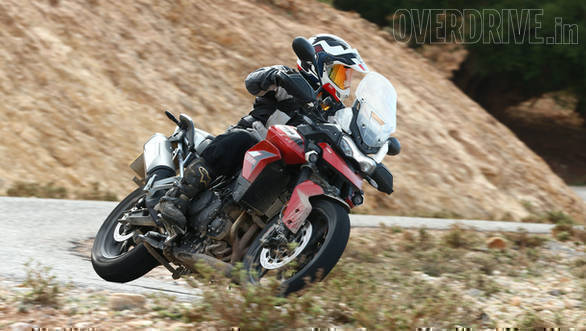
That said, 95PS still makes the Tiger 900, feel like a Tiger should - springily and responsive - and that is good news. If anything, with the increased capacity and the relatively better power to weight, the bike feels quicker when you whack open the throttle and Triumph confirms that the 900 is indeed quicker to the ton by almost a second (3.8s versus the 800's 4.71s)! The Tiger 800 was known to feel like a fast street naked when it came to on-road performance. Good news is, the engine still feels strong around the top end. If you were to ride around the world and chance yourself upon road like the German autobahn without any speed limits, the Tiger 900 will reward you with speeds beyond 200kmph, and without the engine feeling stressed. Impressive? Of course! What's even better is that the chassis feels stable at that speed and the tyres complement the feat (don't ask how we know!). What's more, there is a two-way quick shifter too and it works flawlessly well, just like the Street Triple RS.
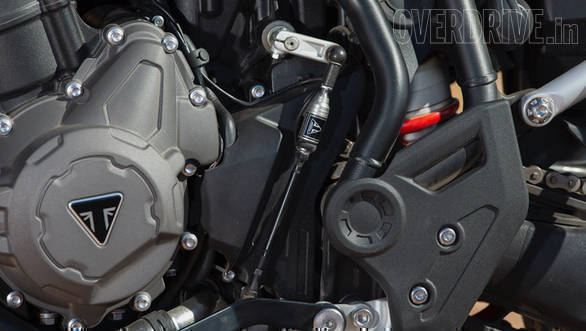 The engine features a bi-directional quick-shifter derived from the Street Triple RS, and works equally well off the road too!
The engine features a bi-directional quick-shifter derived from the Street Triple RS, and works equally well off the road too!
The gearing is setup up such that while the 2nd, 3rd and 4th gears give you a strong acceleration in all load conditions, you can also potter around town peacefully in 4th with speeds as low as 45kmph. Meanwhile, the 5th and the 6th gears will quickly settle at a low engine speed while cruising on the highway, needing between 4-5,000rpm for 100-125kmph. The new assisted clutch, which is significantly lighter than before, makes working this gearbox less cumbersome to use in traffic. The only fly in the ointment are vibrations that are noticeable in the pegs and the handlebar between 4-8,000 rpm. I quite like them because it goes with the grunty nature of the engine, but if I was putting 8-900kms in the saddle all day long, the vibrations could leave me a little irritated by the end of it. Heavier bar-ends could solve it.
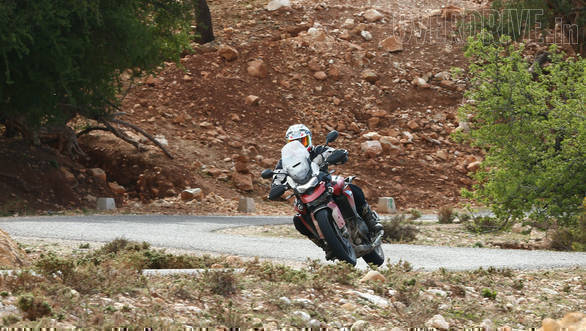 The new 900cc engine has noticeable vibrations between 4-8,000rpm
The new 900cc engine has noticeable vibrations between 4-8,000rpm
I wasn't too impressed with the windshield, as I couldn't find a single position that would completely get rid of the buffeting beyond 130kmph. It doesn't intrude with your line of vision even at the highest position though. While its design is very similar to the outgoing Tiger's, the mechanism now has a brace that seems to have eliminated the clunky sound of the outgoing unit. Speaking of clunky sounds, our test bikes were not fitted with the main stand, so I can't confirm if that infamous clunk from the bottom of the bike has been eliminated or not. The suspension is definitely silent though - even on the Rally Pro.
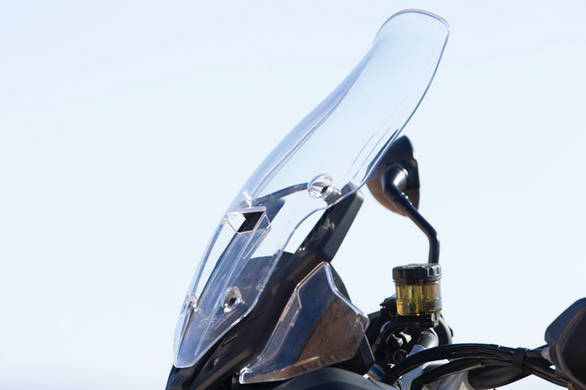 The windscreen has a five-step adjustment similar to the outgoing bike, but the mechanism is stronger
The windscreen has a five-step adjustment similar to the outgoing bike, but the mechanism is stronger
Why electrically adjustable suspension only to the rear? Primarily to save cost. That's also the reason why the suspension comes from a lesser-known Italian brand - Marzocchi. You can make adjustments to the preload (via four presets for rider/pillion/luggage) and the damping (across nine levels). I found the damping to work best for me around the 6th level. Going closer to comfort made it very squishy, the Sport made it nice and taut but the front didn't cope up. Thankfully, the front suspension is adjustable too, but I would have to play around it longer and get the setup right. So get trained for that.
We rode from Marrakech to Essaouira through some stunning mountain roads, B-roads and the open highways - amounting to about 330kms in a day. All-day in the saddle is absolutely comfortable despite the narrower seat. From the saddle, the display looks crisp and easy to read at all times and since the screen is bonded closer to the glass now, it has lesser reflections too. Out of the four layout styles, Style 4 worked best for me, but I wish the Rev counter was easier to read and that there was an option of displaying minimal data than what it currently offers. The rider triangle is also fairly relaxed, but with the relatively sharp handling dynamics of this motorcycle, scraping the pegs is far too easy. The bike ships with Metzler Tourance next tyres, which were squirming a bit at higher lean angles, but knowing how capable they are, I believe it is down to the suspension which wasn't set up to my preference. While the bike feels light on its feet while munching miles, around the twisties it can still feel quite a handful to pick up and throw around. That could seem like a bit of work to some riders and may not feel as effortless as some of the competition. But overall, the GT Pro is a very enjoyable machine like it's predecessor and all the enhancements make it a more comfortable sports tourer than before. But whether or not you take a liking to its new sound and engine character is something that could heavily influence what kind of feel and how much involvement you get from this motorcycle, so do take a long test ride before you commit the money.
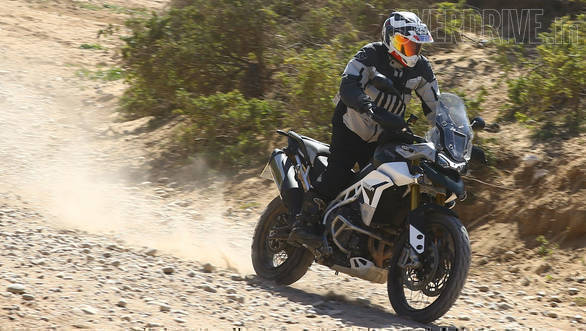
The inherent character of the new Tiger 900 suits the Rally more than the GT. From the way it looks in Triumph's Tramontana Rally Raid project inspired livery, to the way it stands on that long-travel suspension and tall wheels, the Rally Pro exudes the confidence and off-road ability of this new platform.
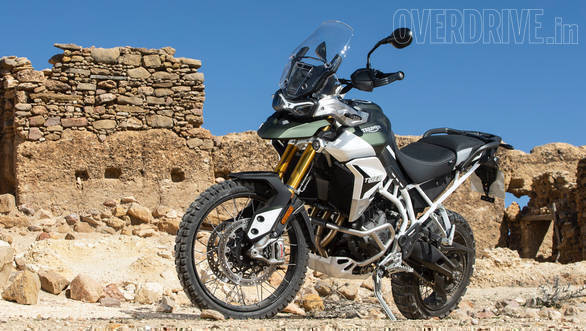 The Rally Pro's visual differentiators include the stunning Triumph Tramontana Rally Raid project inspired Khaki Green and White scheme with the white frame, tubeless wire-spoke wheels (F21/R17), the golden coloured Showa forks, the engine and sump protectors, and the metal plates flanking headlights
The Rally Pro's visual differentiators include the stunning Triumph Tramontana Rally Raid project inspired Khaki Green and White scheme with the white frame, tubeless wire-spoke wheels (F21/R17), the golden coloured Showa forks, the engine and sump protectors, and the metal plates flanking headlights
And no, the new tubeless wheels can't be retrofitted on the 800 because the PCD is different, neither are they recommend on the GT, unless you are ready to swap the suspension too to accommodate the 21-inch wheel size. Compared to the GT, the handlebar on the Rally Pro is 5mm wider, the footpegs are set rearward and the rear brake lever is off-road friendly with its bear-trap design, a relatively higher position for ease while standing up and riding, and folding design to avoid bending or breakage in case of a fall. Out on the highway though, you will have to get used to the brake lever's position.
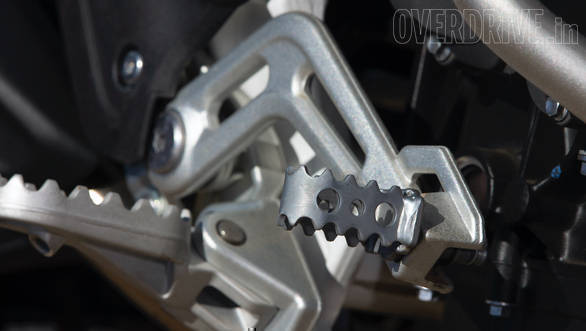
Even the LED turn blinkers up front have learned from the 800 are now set higher and out of harm's way when the bike takes a fall, but the high mounting of the turn blinkers at the rear is a concern for those who carry wide aftermarket tail bags that droop on their sides. The new design of the radiators will also necessitate protection frames, and thankfully Triumph has one available in the accessories, that will also cover the tank.
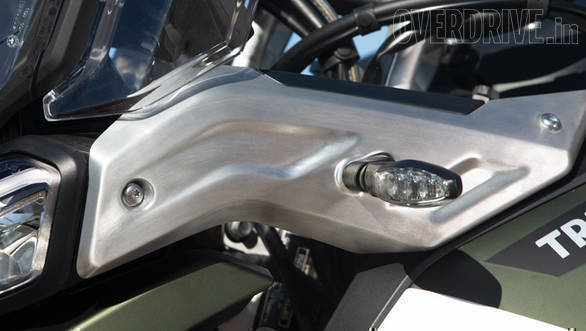 The front turn blinkers are set higher now and out of harm's way
The front turn blinkers are set higher now and out of harm's way
Like I mentioned right at the start - with the Tiger, know what you want, no why you need. And please do not make thy decision based on the price or the seat height. Definitely take a test ride of both before you make a decision. The Rally Pro is a different beast altogether. The question we began with, does it feel like two engines in one? Oh yes. That low-end shove is brilliant. It's not the Scrambler 1200 kinda grunty and hooliganism - but there is enough grunt in there to do the trails, power out of the sand and leave rooster trails. There is a better connection between you, the power and the road. And that's something that I have missed on the previous Tiger.
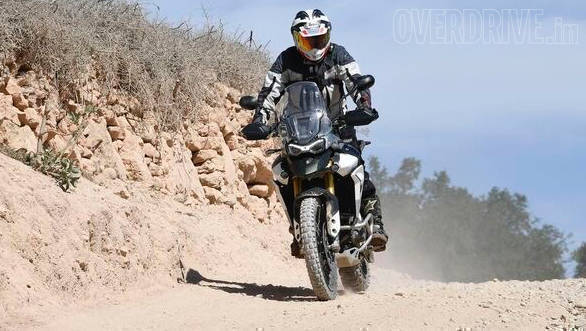
The other thing I love about it is the level of front end feel the Rally Pro offers over the XCx. It's a lot more communicative now. The revised handlebar geometry also makes the front feel more planted. What's even more impressive is how the chassis complements riding intent. With the Off-Road Pro mode, in which we did most of the trail and the beach and even with the electronics turned off, the Rally is massive fun. What feels like hairy moments on some big Advs, make you laugh out loud inside your helmet - that's the level of fun it offers.
We raided a beach, raced through some fields and crossed some slushy stuff too. I even dropped the bike while having all the fun - and picking up this new Tiger is now so much easier.
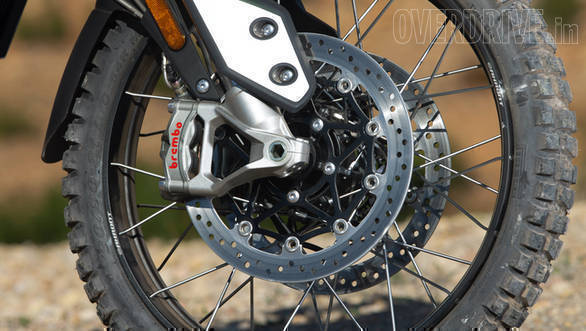 The Brembo Stylema brakes are tuned differently on both the variants and get steel-braided lines on the Rally Pro
The Brembo Stylema brakes are tuned differently on both the variants and get steel-braided lines on the Rally Pro
The Brembo Stylema brakes are one the best in the business and while they are sports-bike level of sharp on the GT Pro, on the Rally Pro, they bite less aggressively when you engage off-road mode. I have a bit of a gripe with these mode selections though. Even with a new advanced IMU that enables cornering ABS and a new, less-intrusive and very dependable traction control system, switching between the road and off-road modes still needs you to come to a complete halt. Furthermore, the tyre pressure monitoring system which is standard on the Pro models will fill up the screen with a large, unavoidable warning when you drop the pressures for road use. But who's looking at the screen anyway!
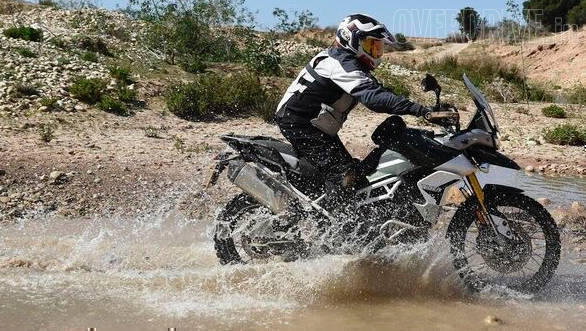 The front end is a lot more communicative than the previous generation, making the Rally Pro way more manageable and enjoyable than before
The front end is a lot more communicative than the previous generation, making the Rally Pro way more manageable and enjoyable than before
The new Showa suspension is the star of these enhanced abilities of the bike. While the WP on the XC is an excellent setup in itself, the Showa setup pushes the envelope further. Even though I don't possess the skills of a rally rider or a seasoned off-road enthusiast, the difference in the suspension behaviour isn't hard to notice. Compared to the single tension springs in the GT's Marzocchi forks, the Showas have Dual rate springs in the forks. While many hoped for progressive springs, which should still be doable on your own, this setup will work extremely well for most riders and enthusiasts. Getting an electronic suspension of similar abilities would significantly escalate costs, says Triumph, but having it at least as an option like on the new Africa Twin would have been the right move in my books.
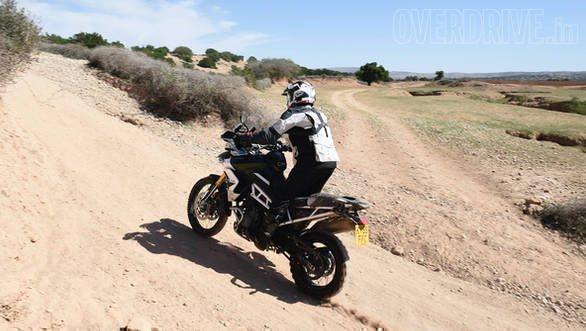
Verdict
In fact, a battle between the new African Twin, the 790 Adventure and the new Tiger 900 is going be a very interesting one. But that is a story for another day, which shouldn't be too far from now. But as for the Tiger 900, these new models are a major step up for Triumph and build on only the attributes of their predecessor, making them one of the best proportions in the middleweight ADV category!
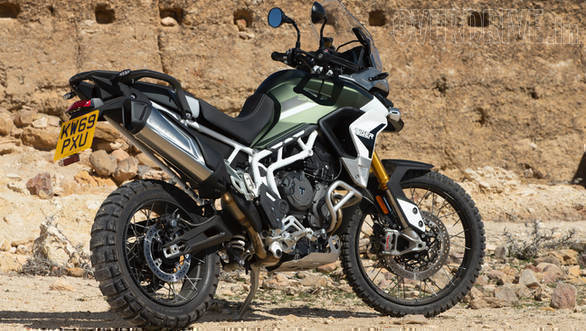
So how are they on each other's terrain? Well the GT Pro will do most of the mild trials and gravely roads that you will toss at it. So poor roads aren't a worry for it. It also got an off-road mode at that. But give it rocky, slushy and mucky terrain and it starts breaking a sweat. The Rally Pro, on the other hand, will keep up with the GT on the tarmac. Sure it doesn't feel as sharp to turn in, or not as aggressive on brakes, but it will do the job well enough to put a smile on your face. And that smile gets even wider and wider as you challenge it with more kinds of terrain. It's the more do it all motorcycle in that sense. I think it also looks better and if I was buying this would be the one to go with. If I was recommending one - it would still be this.
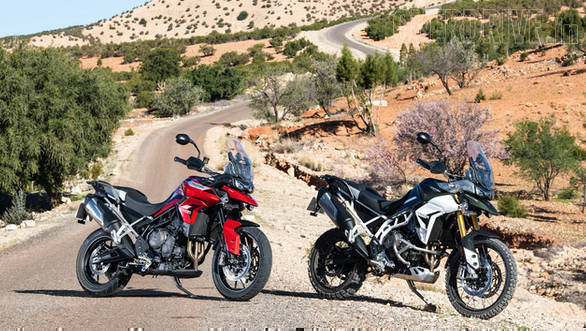 The Triumph Pro, Rally and Rally Pro will be launched in India in the month of April 2020 with prices expected to be in the range of Rs 14-16 lakh ex-showroom
The Triumph Pro, Rally and Rally Pro will be launched in India in the month of April 2020 with prices expected to be in the range of Rs 14-16 lakh ex-showroom
Now the important question - should you upgrade from your 800 to the new 900? It again depends on what you have and what you want. If you already own the XR or XRx, then GT Pro may not be the best upgrade. I'm my books, the swankier dash and the electronic suspension aren't reason enough for the premium you will have to shell out after the trade-in. Similarly, if you are on an XCx, the Rally Pro will offer many enhancements not just on equipment but also on the feel - but will it justify the price that you will have to pay over your current 800 is something only you can decide. However, if you have a road-going Tiger and like many out there you have realised that the off-road variant would have been the right choice to begin with - then the Rally Pro would be a great upgrade in all respects and worth every bit of money you will spend on it.
Starts Rs 13,70,000
888cc
6-Speed
95.20
93.90
19.23 Kmpl
Starts Rs 8,84,000
765cc
6-Speed
118.00
79.00
-NA-
